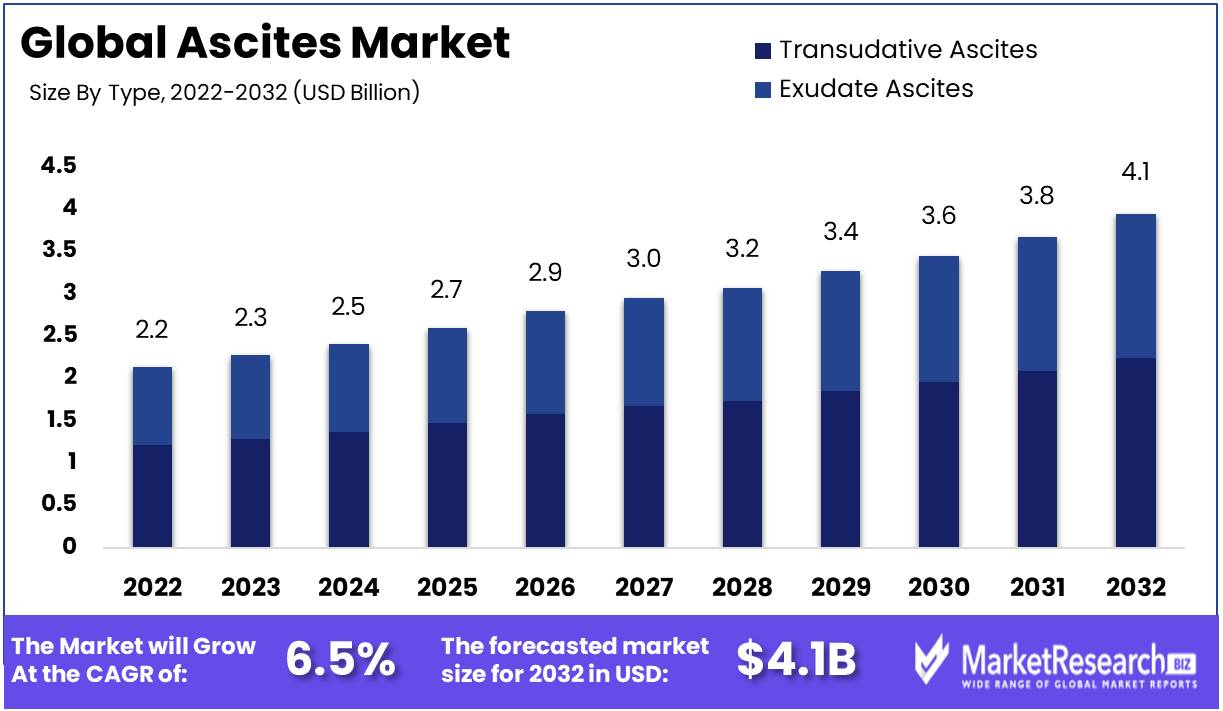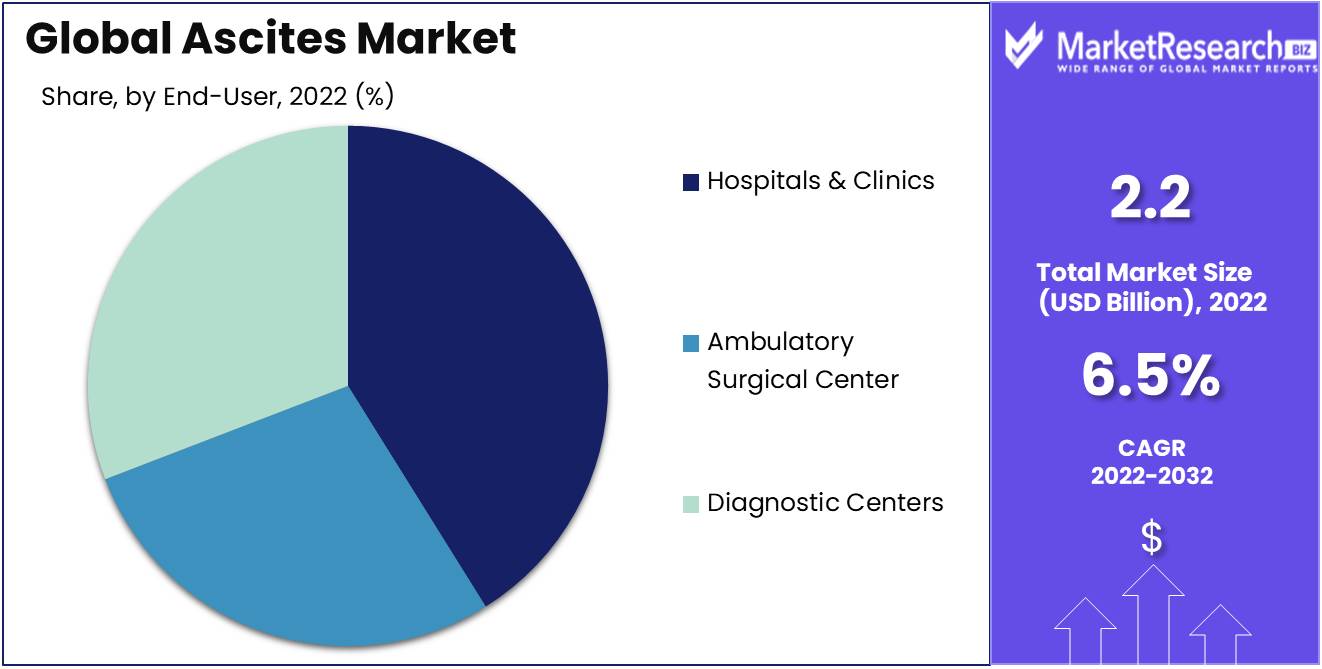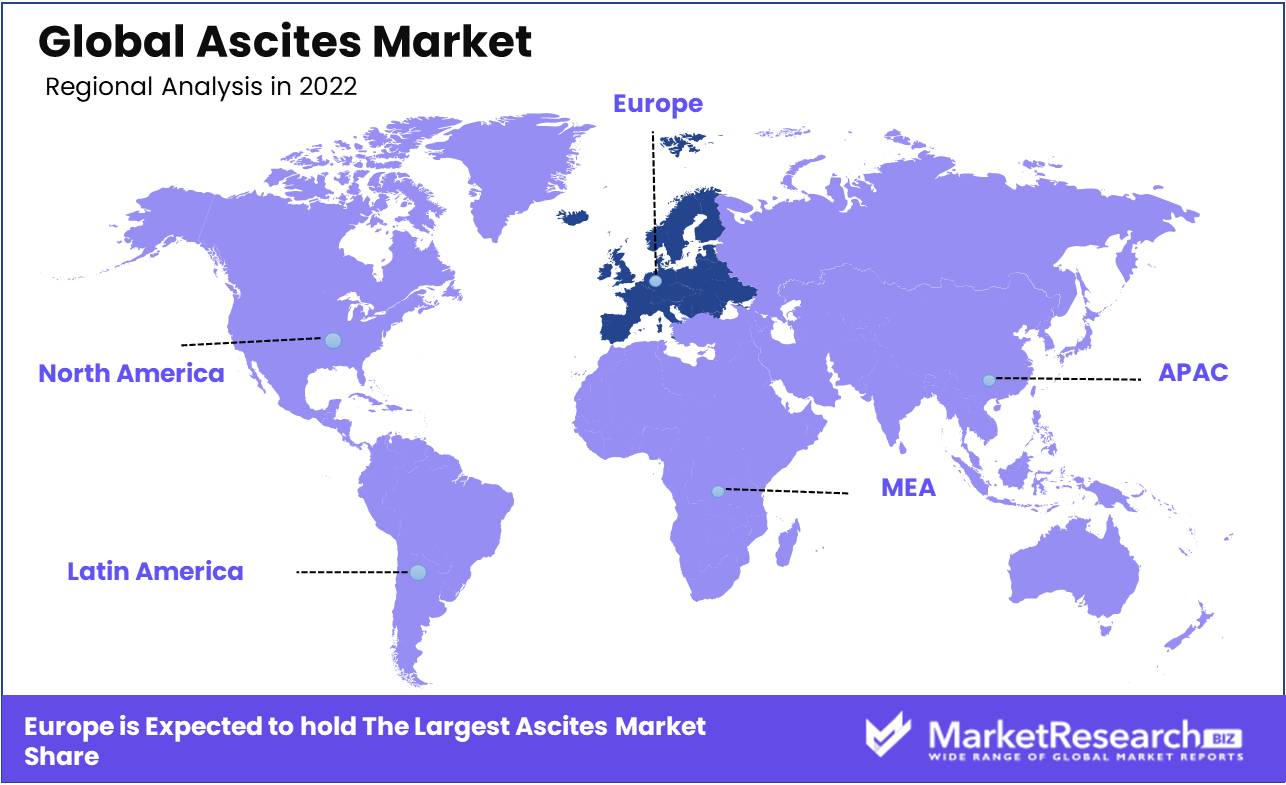
Ascites Market By Type (Transudative Ascites, Exudate Ascites), By Diagnosis (Ultrasound, CT Scan, Laparoscopy, Angiography), By End Users (Hospitals & Clinics, Ambulatory Surgical Center, Diagnostic Centers), By Region And Companies - Industry Segment Outlook, Market Assessment, Competition Scenario, Trends, And Forecast 2023-2032
-
37592
-
June 2023
-
168
-
-
This report was compiled by Correspondence Linkedin | Detailed Market research Methodology Our methodology involves a mix of primary research, including interviews with leading mental health experts, and secondary research from reputable medical journals and databases. View Detailed Methodology Page
-
Quick Navigation
Report Overview
Ascites Market size is expected to be worth around USD 4.1 Bn by 2032 from USD 2.2 Bn in 2022, growing at a CAGR of 6.5% during the forecast period from 2023 to 2032.
The Global Ascites Market, brimming with momentum and allure, arises as a result of the rising prevalence of liver-related diseases and the accelerating adoption of innovative medical technologies. Ascites, a confounding condition in which fluid accumulates in the abdominal cavity, causing pronounced swelling and excruciating pain, are of paramount concern.

Ascending the rankings of medical complexities, ascites is a condition characterized by the accumulation of fluid in the abdominal cavity, which can result from a variety of medical conditions, such as liver cirrhosis, heart failure, cancer, and infection. This accumulation of fluid not only causes discomfort but also results in labored respiration and excruciating abdominal pain as a result of its subtle effects. A multifaceted approach awaits in the domain of treatment, including medication, lifestyle changes, and surgical interventions such as paracentesis and shunt surgery. Unquestionably, the urgency and promptness of diagnosing and treating ascites should not be undervalued, as they have the potential to prevent severe complications and improve the patient's quality of life.
The introduction of innovative technologies and methods in the field of ascites has paved the way for substantial advances in diagnosis and treatment. Among these transformative innovations, the use of minimally invasive procedures, such as laparoscopy and peritoneoscopy, takes center stage, providing relief from lengthy recuperation periods and facilitating accelerated recovery. In addition, the use of computer-assisted procedures, such as virtual colonoscopy and CT angiography, has revolutionized the visualization of the abdominal cavity, spawning more precise and meticulous ascites diagnosis and treatment options.
The ethical dilemma surrounding the use of ascites in medical research and development has sparked a heated debate and necessitated a paradigm shift toward accountable and transparent practices. Transparency, explainability, and accountability must be diligently pursued to ensure the prudent application of ascites within the domain of medical research. Similarly, meticulous monitoring of commercial uses of ascites remains essential, with the ethical compass serving as a guidepost and vigilantly preventing violations of ethical principles and standards. The responsible utilization of ascites is essential to maintaining the trust, confidence, and integrity of patients, healthcare professionals, and society.
Driving Factors
Increasing Prevalence of Liver Cirrhosis
Cirrhosis of the liver is one of the leading causes of ascites, and its prevalence is on the rise worldwide. The rising incidence of liver cirrhosis is attributable to factors including excessive alcohol consumption, viral hepatitis infections, and nonalcoholic fatty liver disease. The increasing number of patients with liver cirrhosis drives the demand for ascites treatment, thereby impacting the ascites market.
Increasing Geriatric Population
Ascites affects primarily the geriatric population. As the global population ages, it is anticipated that the prevalence of ascites will increase. The elderly are more susceptible to liver cirrhosis, cardiac failure, and other ascites-related conditions. The increase in the elderly population contributes to the growth of the ascites market.
Rising Awareness and Diagnosis
Awareness of the symptoms and consequences of ascites among both healthcare professionals and patients leads to early diagnosis and treatment. Detection and treatment of ascites in a timely manner enhance patient outcomes and quality of life. As awareness and diagnosis rates increase, so does the demand for ascites treatment, driving market expansion.
Product Innovations and Pipeline Development
Pharmaceutical and medical device companies are investing heavily in R&D to introduce new and improved ascites management products to market. This includes the creation of innovative pharmaceuticals, devices, and combination therapies. Continual pipeline development and product innovations contribute to market expansion by increasing the number of treatment options accessible to healthcare providers and patients.
Restraining Factors
Limited Treatment Options
The limited treatment options available are one of the primary barriers to the expansion of the Global Ascites Market. Current treatments for the management of ascites emphasize sodium restriction, diuretic therapy, and paracentesis. These treatments are merely palliative and do not offer a permanent remedy for the condition.
As a result of the dearth of effective treatment options, the cost of managing ascites has increased significantly. Frequent hospitalizations for paracentesis procedures are physically and emotionally exhausting for patients with ascites. In addition, these procedures can result in a variety of complications, such as infection, hemorrhage, and hypotension, which increases the risk of morbidity and mortality.
Procedural Risks
The procedural risks associated with ascites management are another factor that has a significant impact on the Global Ascites Market. The most common treatment for ascites, paracentesis, entails the risks of infection, bleeding, and hypotension. In addition, repeated procedures may result in the formation of abdominal adhesions, which can further complicate the management of ascites.
In addition to paracentesis, the implantation of a permanent peritoneal catheter is employed to treat ascites. Several complications are linked to this procedure, including catheter-related infections, malpositioning, and catheter occlusion. In addition, the procedure's expense and need for regular maintenance restrict its pervasive application.
The Underlying Cause of Identification
Effective ascites management necessitates identification of the underlying cause. Nonetheless, this can be difficult, particularly when the patient has multiple underlying conditions. Failure to identify the underlying cause can result in ineffective treatment and a poor prognosis for the condition.
Resource Constraints
The Global Ascites Market's expansion is also significantly hampered by resource constraints. Ascites may be misdiagnosed and improperly treated in low-income countries due to a lack of access to sophisticated healthcare facilities and trained medical personnel. In addition, the high cost of managing ascites in high-income countries can limit the treatment's accessibility to a large population.
Type Analysis
The dominance of the Exudate Ascites Segment in the Global Ascites Market is indicative of the efficacy and efficiency of this treatment. With its ability to effectively manage ascites, the Exudate Ascites Segment has become the world's foremost treatment option for ascites management.
The adoption of the Exudate Ascites Segment is driven by the economic growth of developing nations. As these economies continue to expand, their healthcare systems become increasingly advanced and sophisticated, resulting in a rise in demand for the Exudate Ascites Segment.
Due to its efficacy and ease of use, the Exudate Ascites Segment has garnered positive consumer sentiment, with more patients opting for this form of treatment. Patients are now more aware of the efficacy of the Exudate Ascites Segment, and an increasing number of healthcare providers are recommending it as the initial treatment for ascites.
Diagnosis Analysis
Due to its non-invasive and secure nature, the Ultrasound Segment is the leading type of treatment in the Global Ascites Market. Due to its superior imaging capabilities, Ultrasound Segment has become the diagnostic method of choice for ascites.
Similar to the Exudate Ascites Segment, the adoption of the Ultrasound Segment is driven by the economic development of emerging economies. Recognizing the significance of early diagnosis, healthcare providers in these economies are increasingly adopting Ultrasound Segment for ascites screening.
The consumer attitude toward the Ultrasound Segment is positive, with patients opting for this non-invasive diagnostic procedure over others that are invasive. Patients have faith in Ultrasound Segment's precision and dependability, resulting in an increased demand for its use.
End Users Analysis
The Global Ascites Market is dominated by the Hospitals & Clinics Segment. This is due to the large number of patients seeking treatment for ascites in these hospitals, which provide the necessary apparatus and expertise to effectively manage the condition.
As these healthcare facilities become more advanced and sophisticated, the economic development of emerging economies is propelling the adoption of the Hospitals & Clinics Segment. As more patients seek treatment for ascites, there is an increase in demand for the Hospitals & Clinics Segment.
Patients trust the expertise and experience of the healthcare providers, which is positive consumer behavior toward the Hospitals & Clinics Segment. Because of the availability of specialized apparatus and trained personnel, patients are more likely to seek care in hospitals and clinics.

Key Market Segments
By Type
- Transudative Ascites
- Exudate Ascites
By Diagnosis
- Ultrasound
- CT Scan
- Laparoscopy
- Angiography
- Other Diagnosis
By End Users
- Hospitals & Clinics
- Ambulatory Surgical Center
- Diagnostic Centers
Growth Opportunity
The Role of Novel Management Therapies in Driving the Global Ascites Market
Paracentesis, peritoneovenous shunt, transjugular intrahepatic portosystemic shunt, and pharmacotherapy are reshaping the global ascites market. Utilizing a catheter, the paracentesis procedure involves the removal of excess fluid. In patients with liver cirrhosis, a peritoneovenous shunt is implanted to help drain fluid, whereas a transjugular intrahepatic portosystemic shunt is a minimally invasive procedure that uses a stent to divert blood to bypass a damaged liver. In pharmacotherapy, pharmaceuticals such as diuretics, vasoconstrictors, and vasodilators are utilized. These innovative management therapies have played a crucial role in decreasing hospitalization rates, duration of stay, and overall mortality.
The Role of Minimal Invasive Procedures in Driving the Global Ascites Market
The global ascites market has undergone a major transition toward minimally invasive procedures. These procedures have significantly reduced patient discomfort and accelerated recovery time. Laparoscopy and percutaneous transhepatic cholecystomy (PTC) are acquiring popularity as minimally invasive procedures. A telescope-like instrument is inserted through small incisions to investigate and treat abdominal organs via laparoscopy. PTC involves inserting a catheter directly into the gallbladder through the skin to relieve bile duct obstruction. These minimally invasive procedures are associated with shortened hospital stays, fewer complications, and decreased costs.
The Role of Personalized Medicine in Fueling the Global Ascites Market
Rapid advancements in genomics and personalized medicine have played a crucial role in enhancing patient outcomes on the global ascites market. Personalized medicine involves tailoring a patient's treatment to their specific needs, taking into account their genetic composition and other preferences. Precision medicine is anticipated to play a crucial role in the development of innovative diagnostic and therapeutic techniques. Through the use of genetic testing, doctors are able to diagnose the underlying condition and provide individualized treatment. With ongoing research in this area, personalized medicine has an enormous potential to effectively treat ascites.
The Role of Interdisciplinarity Collaborations in Driving the Global Ascites Market
Collaborations across disciplines are essential to fostering innovation in the global ascites market. The collaboration between healthcare providers, pharmaceutical companies, and medical device manufacturers has paved the way for the creation of innovative diagnostic instruments and treatments. The integration of laboratory tests and advanced imaging technologies has increased diagnostic precision and therapeutic efficacy. These partnerships have produced effective treatments for ascites, increased patient satisfaction, and enhanced care quality.
Latest Trends
Advancements in Paracentesis and TIPS Procedures
Procedures such as paracentesis and Transjugular Intrahepatic Portosystemic Shunts (TIPS) are frequently used to treat ascites. TIPS entails the construction of a shunt between the portal and hepatic veins, whereas paracentesis involves the removal of fluid from the abdomen.
These procedures have evolved to become more efficient, secure, and effective. For example, image-guided paracentesis has become commonplace, reducing the need for hospitalization and enhancing patient outcomes.
Similarly, the development of covered stents that reduce the incidence of hepatic encephalopathy has enhanced TIPS procedures. These developments have contributed to the expansion of the ascites market by increasing the demand for these procedures.
Albumin Infusion Therapy
Albumin infusion therapy consists of the intravenous administration of albumin, a protein present in blood plasma. This treatment is administered to ascites patients to increase their blood volume and blood pressure.
Albumin infusion therapy has become a more effective and secure treatment option, especially for patients with refractory ascites, as a result of recent advancements. These developments involve the creation of novel formulations, dosing strategies, and administration techniques.
Prevention and Early Intervention Focus
Prevention and early treatment are crucial in the management of ascites. These methods can prevent the occurrence of complications and improve patient outcomes. In recent years, there has been a growing emphasis on prevention and early intervention.
This trend has led to the development of new diagnostic instruments and screening methods that can detect ascites at an earlier stage. These instruments consist of ultrasound, CT scans, and diagnostic tests.
In addition, a greater emphasis has been placed on lifestyle modifications, such as dietary alterations and physical activity, that can reduce the risk of developing ascites. This emphasis on prevention and early intervention is anticipated to stimulate growth in the ascites market over the next few years.
Palliative Care Integration
Palliative care is a method of treatment that emphasizes enhancing the quality of life for patients with life-threatening conditions. It incorporates symptom management as well as psychosocial and spiritual support.
It has been demonstrated that incorporating palliative care into the management of ascites improves patient outcomes and reduces the burden on healthcare systems. This integration includes the early identification of patients who may benefit from palliative care and the provision of supportive care throughout the course of treatment.
Regional Analysis
Ascites are the accumulation of fluid in the abdominal cavity, which affects millions of individuals worldwide. Europe dominates the ascites market. It is frequently a complication of cirrhosis of the liver, but can also be caused by heart failure and malignancy. The market for ascites is anticipated to expand consistently over the next few years, with Europe as the dominant player.
Europe is home to some of the world's top pharmaceutical companies specializing in the development of ascites treatments. These companies have made substantial investments in research and development to create innovative therapies that treat the underlying cause of ascites and provide patients with symptomatic relief.
The ascites treatment market in Europe is highly competitive, with numerous companies contending for market share. However, companies with a strong emphasis on research and development are anticipated to succeed. They can utilize their expertise in the field to create therapies that effectively address the requirements of patients. AbbVie, Pfizer, and Bayer are among the main market participants.
The ascites market in Europe is expected to grow consistently over the next few years, fueled by rising awareness of the condition and the development of novel treatments. Countries such as Germany, France, and the United Kingdom are anticipated to be significant market growth contributors.

Key Regions and Countries
North America
- US
- Canada
- Mexico
Western Europe
- Germany
- France
- The UK
- Spain
- Italy
- Portugal
- Ireland
- Austria
- Switzerland
- Benelux
- Nordic
- Rest of Western Europe
Eastern Europe
- Russia
- Poland
- The Czech Republic
- Greece
- Rest of Eastern Europe
APAC
- China
- Japan
- South Korea
- India
- Australia & New Zealand
- Indonesia
- Malaysia
- Philippines
- Singapore
- Thailand
- Vietnam
- Rest of APAC
Latin America
- Brazil
- Colombia
- Chile
- Argentina
- Costa Rica
- Rest of Latin America
Middle East & Africa
- Algeria
- Egypt
- Israel
- Kuwait
- Nigeria
- Saudi Arabia
- South Africa
- Turkey
- United Arab Emirates
- Rest of MEA
Key Players Analysis
BioTek Marine, Inc., Cara Therapeutics, Inc., Fresenius SE & Co. Each of these businesses has a strong market presence and utilizes its expertise to meet the patients' requirements.
The global leader in medical technology, Medtronic plc, has a significant presence in the ascites market. The company offers effective treatment options, such as the minimally invasive PleurX Drainage System, which provides long-term respite to patients with recurrent ascites.
Gilead Sciences, Inc., a biopharmaceutical company, offers patients with ascites caused by liver disease effective treatment options. The US Food and Drug Administration has approved Veklury (remdesivir) for the treatment of COVID-19, which can cause ascites.
Top Key Players in Ascites Market
- BioTek Marine Inc
- Cara Therapeutics Inc
- Fresenius SE & Co. KGaA
- GI Dynamics Inc
- Gilead Sciences Inc.
- Medtronic plc
- F. Hoffmann-La Roche Ltd.
- Teva Pharmaceutical Industries Ltd.
- Sanofi SA
- AstraZeneca
- Johnson & Johnson Private Limited
- Merck & Co. Inc.
- Eli Lilly and Company
- Sun Pharmaceutical Industries Ltd.
- Pfizer Inc.
- Novartis AG
Recent Development
- In 2023, Astellas Pharma announced that it had signed a licensing agreement with Mirati Therapeutics for the development and commercialization of a drug candidate for the treatment of ascites. This partnership is expected to leverage the capabilities of both companies and advance the field significantly.
- In 2022, Gilead Sciences announced that it had acquired Principia Biopharma, a company developing a new ascites treatment. The resources and expertise of Gilead Sciences are anticipated to expedite the treatment's introduction to the market, giving promise to patients suffering from this challenging condition.
- In 2021, Johnson & Johnson announced a partnership with Arbutus Biopharma to develop and commercialize an ascites drug candidate. The agreement combines the assets of both companies, and it is anticipated that the partnership will result in significant market advancements.
- In 2020, Novartis announced that it had submitted a new drug application to the FDA for its ascites drug candidate. This represents a significant advance in the development of a treatment for this condition.
Report Scope
Report Features Description Market Value (2022) USD 2.2 Bn Forecast Revenue (2032) USD 4.1 Bn CAGR (2023-2032) 6.5% Base Year for Estimation 2022 Historic Period 2016-2022 Forecast Period 2023-2032 Report Coverage Revenue Forecast, Market Dynamics, COVID-19 Impact, Competitive Landscape, Recent Developments Segments Covered By Type (Transudative Ascites, Exudate Ascites)
By Diagnosis (Ultrasound, CT Scan, Laparoscopy, Angiography, Other Diagnosis)
By End Users (Hospitals & Clinics, Ambulatory Surgical Centers, Diagnostic Centers)Regional Analysis North America – The US, Canada, & Mexico; Western Europe – Germany, France, The UK, Spain, Italy, Portugal, Ireland, Austria, Switzerland, Benelux, Nordic, & Rest of Western Europe; Eastern Europe – Russia, Poland, The Czech Republic, Greece, & Rest of Eastern Europe; APAC – China, Japan, South Korea, India, Australia & New Zealand, Indonesia, Malaysia, Philippines, Singapore, Thailand, Vietnam, & Rest of APAC; Latin America – Brazil, Colombia, Chile, Argentina, Costa Rica, & Rest of Latin America; the Middle East & Africa – Algeria, Egypt, Israel, Kuwait, Nigeria, Saudi Arabia, South Africa, Turkey, United Arab Emirates, & Rest of MEA Competitive Landscape BioTek Marine Inc, Cara Therapeutics Inc, Fresenius SE & Co. KGaA, GI Dynamics Inc, Gilead Sciences Inc., Medtronic plc, F. Hoffmann-La Roche Ltd., Teva Pharmaceutical Industries Ltd., Sanofi SA, AstraZeneca, Johnson & Johnson Private Limited, Merck & Co. Inc., Eli Lilly and Company, Sun Pharmaceutical Industries Ltd., Pfizer Inc., Novartis AG Customization Scope Customization for segments, region/country-level will be provided. Moreover, additional customization can be done based on the requirements. Purchase Options We have three licenses to opt for Single User License, Multi-User License (Up to 5 Users), Corporate Use License (Unlimited User and Printable PDF) -
-
- BioTek Marine Inc
- Cara Therapeutics Inc
- Fresenius SE & Co. KGaA
- GI Dynamics Inc
- Gilead Sciences Inc.
- Medtronic plc
- F. Hoffmann-La Roche Ltd.
- Teva Pharmaceutical Industries Ltd.
- Sanofi SA
- AstraZeneca
- Johnson & Johnson Private Limited
- Merck & Co. Inc.
- Eli Lilly and Company
- Sun Pharmaceutical Industries Ltd.
- Pfizer Inc.
- Novartis AG




